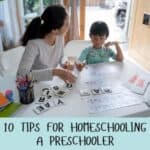Homeschooling Multiple Ages in Your Homeschool with Literature
The Fervent Mama uses Affiliate Links. See our disclosure policy here.
Having several grades can make homeschooling difficult. There are multiples of every subject. Just correcting math problems alone could take hours, so how can a person homeschool a large family? We have homeschooled for eighteen years, with ten kids.
You don’t have to let go of your academic standards. You won’t be checking papers for hours each day either. There are a few things that helped us have a successful and healthy homeschool.
Homeschooling Multiple Ages in Your Homeschool with Literature

Combine Students That Are Close in Age
I may have had ten kids in kindergarten through twelfth grade, but I have never taught more than three grades in a school year. One of those grades was high school students, working independently with me as a guide. Two grades of like-aged children are not too much.
For the most part, children that are within three years of age can be easily combined with little change to the curriculum. Math is assigned by level and reading books can also be personalized to the student’s skill level.
The main subjects are read by you as the teacher in elementary, so it is very easy to ensure understanding with casual conversations.
You know your children best, so you are the best source to know whether a child can combine with older and younger siblings. While homeschooling multiple ages, we have stretched the ages to four years with an academically advanced student.
We have also moved children between groups as their ages shifted from those childhood years to pre-teen.
A few factors we identify before making a group for the year are…
- Social Maturity
- Ability to Remain Seated for 20 Minutes
- Writing Skills
- Listening and Following Instructions
- Relationships
- Interests
Choose Wisely and Make Adjustments as Needed
Using these factors has helped us in homeschooling multiple ages by creating groups that work well together. One year I had a nonwriter grouped with the siblings that were older and younger than him.
We were doing a Science Curriculum that had a short, fill-in-the-blank worksheet. The first few times we did it together, it was rough.

I could have chosen to move him, but instead, we decided to work around the problem. I got a large whiteboard and wrote an abbreviated answer to each question for him to copy. He improved quite a bit over the year and the siblings were able to work right along with him.
Personality can play a large factor in your homeschool. We had a child who did not learn well with the literature-based curriculum. He has always been a kinesthetic, hands-on learner.
He loved all things computer-based. We peeled him off the group he was in and set him to work on a computer-based curriculum for one year.
You can make changes as needed. The sooner you respond to problems the better in fact. Making a change was just what he needed to get caught up and grow in study skills.
Aging a year was also a big help in developing the maturity needed to listen for longer periods of time.
Literature Based Core Subjects to Streamline the School Day
Reading has been our saving grace. If anyone asks what my number one piece of homeschooling advice is, it is to read books and to read to your kids.
Read great books. Read picture books. Be enthusiastic, silly, fun, and engaging. Make reading the best entertainment in your house in the early years and teaching homeschool will be so much easier.
I have seen the difference between the older kids, who had NO TV until they were in their teens, and my younger kids who can set up my own TV, run a computer, and create a live stream with ease. Build the deepest foundation with books that you can.
Use literature books for your main teaching subjects. You can use a Social Studies textbook, a reading curriculum, a world geography workbook, and the like.

OR, you can read an amazing story about people living in the world, past or present. Look up the location of the story. Mark it on a map of the world.
Which would you choose, three textbooks to read a chapter out of, or everyone on the couch, listening to a beautiful story? We choose to read and end up with the kids begging for “One more chapter!”
To start homeschooling multiple kids together, start by combining multiple ages together for main subject work is a great way for large families to get a large chunk of the school day finished in one meeting.
For us, we meet at the beginning of the school day. The kids have assignments they can work on before we meet, and everyone is expected to have their morning chores done before school.
They are also expected to show up ready, with their books, Bible, and bucket(for supplies like pencils, paper, notebooks, and crayons.)
We begin with Bible reading and memory verses. The older children have devotionals as part of their personal curriculum as well, this is just the reading time together as a family.
Then we jump right into our History, Reading and Social Studies, World View, and Geography all rolled into one, but reading a great book.
We have read thousands of books over the years. We always have a few top favorites every year. At the end of the year, I have them pick their favorite before we put everything away before summer. I love hearing them recall their favorite parts.
We read for science as well. Often this can be combined for a broader range of ages as well. My high school kids love to help the younger ones with experiments and projects.
As they share the work, they are all reinforcing the ideas they are learning in their studies.
Off-Load Big Tasks
Correcting math was taking all day. Spelling was going downhill fast! I needed a new plan, or I was going to bail out on both subjects. Look at your day for the big, time-suckers too.
These are areas that sap your energy as well as your time. Correction can be one, but so can meal planning, lesson prep, discipline, and interruptions.
I suggest when homeschooling multiple children you keep a timesheet for a week and log your time suckers. You might be surprised where they come from.
Two places that they are likely to come from are you, and…you! Lack of planning is one place where we as homeschool leaders can get behind in the day.
Kids lost interest when they must wait for instructions. They can smell when you are lost on a topic. Losing their interest or your place costs time.
Honor all your time by scheduling time for you to get prepared each week. Or, purchase a curriculum that does the planning for you.
Another place you will lose time is in household tasks. These never stop but need to be paused for school. Don’t be tempted to multitask while school is in session.
Stay focused when homeschooling multiple ages and plans. Prep meals, avoid phone calls, set two clean-up sessions each day right before meals.
How you can Homeschool Multiples
By combining kids and these simple ideas, you can have a streamlined homeschool day. You can spend less time correcting and more learning about what you love, together.

This is a contributed post for the 2021 How We Homeschool Series.
Learn more about the How We Homeschool Series, contributors, sponsors, and giveaways by heading here.






















